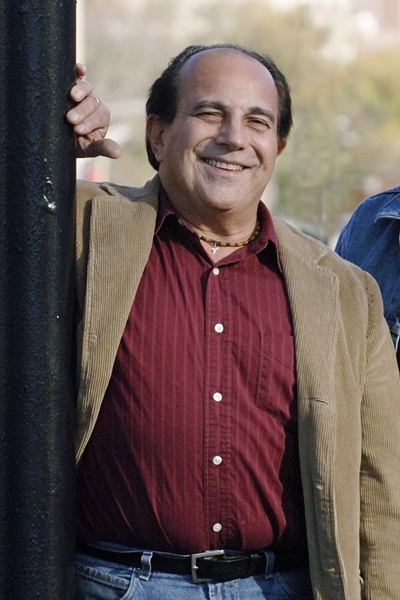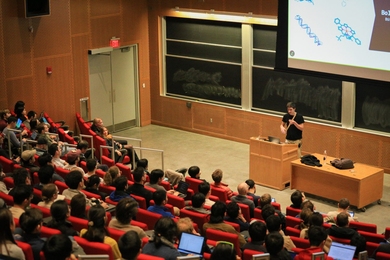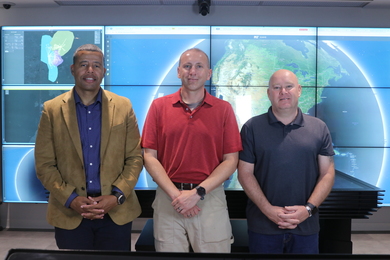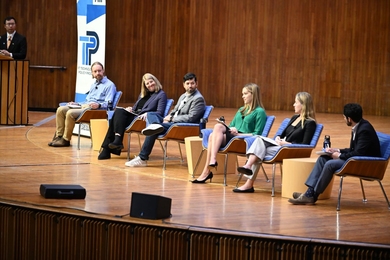Ray Magliozzi '72 is well known for his expertise in auto repair. As the longtime co-host of the NPR radio program Car Talk (with his brother, Tom Magliozzi '58) he can be heard every week on public-radio stations across the nation dispensing automotive advice to listeners in need. Perhaps less understood is that Ray is also a woodworking aficionado who got his first lessons as a teenager in the MIT Hobby Shop.
His appreciation for furniture making, his self-described attempts to make objects that resemble furniture, his history at MIT and his ease and good humor in front of the microphone made Ray a natural pick to give the keynote address at the 2010 Furniture Society Conference. Hosted at the Institute from June 16-19, this biannual conference brings together furniture makers and designers, collectors, educators and curators to address the role of furniture in today's society as well as the historical context and future of contemporary furniture. Prior to his talk, Magliozzi spoke with the Division of Student Life about his interest in woodworking and whether engineers and furniture makers can co-exist.
Q. Everyone knows that you tinker with cars, but what is your involvement with furniture making?
A. I would not call it furniture making. I would call it woodworking. I've made some stuff that resembles furniture, but it hardly qualifies as real furniture. I'd have to say that I've used it over the years as an outlet. Fixing cars can be really frustrating, like lots of jobs. And I am sure lots of people who take up woodworking as a hobby find it a wonderful outlet because it does give you an opportunity to do something that's very different from what you do every day.
Certainly woodworking was not that different in that I worked with my hands, but, number one, it was cleaner dirt. And number two, there was no pressure to get anything done, so when I decided to make something I would get it finished when I got it finished. That was the allure, I think.
Q. Did you use the Hobby Shop at MIT? How important was hands-on learning to your MIT experience?
A. Oddly enough, I used the Hobby Shop before I became a student ... When I was a senior in high school, I bought a harpsichord kit from an outfit in New York called Zuckerman Harpsichords. I thought it was a kit like a Revell model airplane kit. You know — they send you all the pieces, and any moron can put it together. Well, it was a kit, but it also came with blueprints and whatnot for cutting out all the other pieces of the harpsichord that did not come in the kit. And there were a lot of them!
So I was working that summer before my freshman year at MIT — I was working on the grounds crew — and somebody said to me, “Hey, you ought to go find the Hobby Shop, bring in your wood, and maybe you can get it cut up.” That was my first introduction to band saws and table saws and whatnot … This would have been the summer of '66. I found a very helpful gentleman who showed me how to use the table saw and the band saw. He actually cut some of the pieces for me and showed me how to finish the harpsichord. It was a lot of fun.
I remember taking some mechanical-engineering courses where I had to learn how to operate a milling machine and a lathe. I think that was important to me because I'm a hands-on kind of guy. I understand stuff better when I can hold it in my hands. Not that I can't understand abstract things, but if I can hold something, see it and turn it around and look at the underside of it, I can understand it better. That's why fixing cars appealed to me so much, because when you work on automobiles, you can get to the root of the problem by looking at the piece and figuring out how and why it failed perhaps. That always intrigued me. It still does.
Q. You are giving the keynote address at the Furniture Society conference …
A. I know — why'd they think of me?!
Q. ... are furniture makers much different than engineers and scientists? Can they get along?
A. Oh, absolutely. I think furniture makers are certainly the kind of people who are interested in accuracy and precision, and that dovetails nicely — no pun intended — with scientists. A lot of scientists I know are amateur woodworkers, or even better than amateur woodworkers, because it satisfies a need to do things that are abstract. It does make sense that people who are pursuing science would be also interested in woodworking.
His appreciation for furniture making, his self-described attempts to make objects that resemble furniture, his history at MIT and his ease and good humor in front of the microphone made Ray a natural pick to give the keynote address at the 2010 Furniture Society Conference. Hosted at the Institute from June 16-19, this biannual conference brings together furniture makers and designers, collectors, educators and curators to address the role of furniture in today's society as well as the historical context and future of contemporary furniture. Prior to his talk, Magliozzi spoke with the Division of Student Life about his interest in woodworking and whether engineers and furniture makers can co-exist.
Q. Everyone knows that you tinker with cars, but what is your involvement with furniture making?
A. I would not call it furniture making. I would call it woodworking. I've made some stuff that resembles furniture, but it hardly qualifies as real furniture. I'd have to say that I've used it over the years as an outlet. Fixing cars can be really frustrating, like lots of jobs. And I am sure lots of people who take up woodworking as a hobby find it a wonderful outlet because it does give you an opportunity to do something that's very different from what you do every day.
Certainly woodworking was not that different in that I worked with my hands, but, number one, it was cleaner dirt. And number two, there was no pressure to get anything done, so when I decided to make something I would get it finished when I got it finished. That was the allure, I think.
Q. Did you use the Hobby Shop at MIT? How important was hands-on learning to your MIT experience?
A. Oddly enough, I used the Hobby Shop before I became a student ... When I was a senior in high school, I bought a harpsichord kit from an outfit in New York called Zuckerman Harpsichords. I thought it was a kit like a Revell model airplane kit. You know — they send you all the pieces, and any moron can put it together. Well, it was a kit, but it also came with blueprints and whatnot for cutting out all the other pieces of the harpsichord that did not come in the kit. And there were a lot of them!
So I was working that summer before my freshman year at MIT — I was working on the grounds crew — and somebody said to me, “Hey, you ought to go find the Hobby Shop, bring in your wood, and maybe you can get it cut up.” That was my first introduction to band saws and table saws and whatnot … This would have been the summer of '66. I found a very helpful gentleman who showed me how to use the table saw and the band saw. He actually cut some of the pieces for me and showed me how to finish the harpsichord. It was a lot of fun.
I remember taking some mechanical-engineering courses where I had to learn how to operate a milling machine and a lathe. I think that was important to me because I'm a hands-on kind of guy. I understand stuff better when I can hold it in my hands. Not that I can't understand abstract things, but if I can hold something, see it and turn it around and look at the underside of it, I can understand it better. That's why fixing cars appealed to me so much, because when you work on automobiles, you can get to the root of the problem by looking at the piece and figuring out how and why it failed perhaps. That always intrigued me. It still does.
Q. You are giving the keynote address at the Furniture Society conference …
A. I know — why'd they think of me?!
Q. ... are furniture makers much different than engineers and scientists? Can they get along?
A. Oh, absolutely. I think furniture makers are certainly the kind of people who are interested in accuracy and precision, and that dovetails nicely — no pun intended — with scientists. A lot of scientists I know are amateur woodworkers, or even better than amateur woodworkers, because it satisfies a need to do things that are abstract. It does make sense that people who are pursuing science would be also interested in woodworking.






